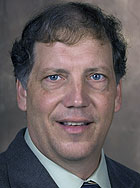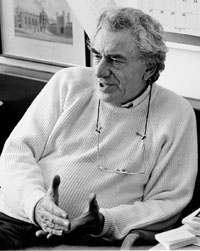If the titans of finance had only been paying attention, they would have seen that former Washington University in St. Louis economics Professor Hyman P. Minsky, PhD, had predicted the Great Recession decades before it happened.

Well, at least he predicted the factors that led to it, explains Steven Fazzari, PhD, professor of economics in Arts & Sciences and associate director of the Murray Weidenbaum Center on the Economy, Government, and Public Policy.
Fazzari will present the First Hyman P. Minsky Lecture at 7:30 p.m. Wednesday, March 2, in the Bryan Cave Moot Courtroom in Anheuser-Busch Hall that explores how the late Minsky’s ideas explain the dramatic economic events of recent years.
The lecture, titled “The Legacy of Hyman Minsky and the Great Recession,” is free and open to the public.
As a young faculty member, Fazzari often heard the occasionally gruff Minsky talk about his Financial Instability Hypothesis. Minsky, who retired from the university in 1990 after 25 years, described his ideas in a book of essays published in 1982 about the Great Depression, Can “It” Happen Again?
His final book in 1986, Stabilizing an Unstable Economy, explored his hypotheses further.
“For most of his career, Minsky was somewhat obscure,” Fazzari says. “People were aware of his work, and some took it seriously, but he was largely out of the mainstream. He was a bit of a voice crying out in the wilderness.”
Minsky theorized that the modern financial system made capitalism inherently unstable, which contrasted with the evolving thinking in mainstream economics during most of his years at the university.
Although Minsky’s ideas were formed by the study of factors that led to the Great Depression, he found elements of financial instability leading up to the recessions of 1980-82 (energy lending), 1990-91 (the savings and loan crisis) and 2001 (the bursting of the tech bubble).

Minsky predicted that the credit cycle goes through five stages before a major downturn occurs: displacement, boom, euphoria, profit taking and panic.
In recent years, these stages were marked by the displacement of low interest rates and expanding access to mortgage credit, a boom in home sales financed by mortgages bundled for sale to investors, nearly insatiable demand for those bundles and skyrocketing home prices, more and more investors entering those markets, huge profits as the markets for houses and mortgage-backed securities became euphoric, and, finally, panic when home sales started to flatten and prices began to decline.
Fazzari says there are a number of factors that flip a boom to a bust, or the “Minsky Moment” (a term Minsky himself never used).
In the case of the Great Recession, these factors included rising interest rates that made it more difficult to finance asset purchases with debt, an increasing spread between the price of an asset (home prices) versus its underlying value, and supply of the asset overtaking demand (too many houses), so that the asset price began to fall.
“This process was operating for about 20 years before the ‘Minsky Moment,’ ” Fazzari says. “Then all of it hit the wall.”
While Minsky’s hypothesis predicted that rising financial fragility would eventually lead to a massive recession, few people were paying attention.
Now, his ideas have been cited in the Wall Street Journal, The New Yorker, the Boston Globe, Foreign Policy magazine and various financial and economic websites.
The Economist magazine conducted a poll of 50 of its contributing economists, asking “which economist was the most influential over the past decade?” Minsky tied for third (after Ben Bernanke and John Maynard Keynes).
The notice would have pleased Minsky, who died in 1996.
“Hyman really did have big ideas and he was so excited when people started following them,” Fazzari says. “His ideas caught on more in other places like Italy, Asia and Latin America than in the U.S.
“The validation of his ideas took decades, not a moment. Now people are paying more attention to him than ever before.”
|
WHO: Steven Fazzari, professor of economics WHAT: The First Hyman P. Minsky Lecture: “The Legacy of Hyman Minsky and the Great Recession” WHEN: 7:30 p.m. Wednesday, March 2
WHERE: Bryan Cave Moot Courtroom, Anheuser-Busch Hall
COST: Free and open to the public
INFORMATION: (314) 935-5652 |